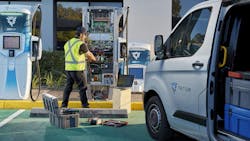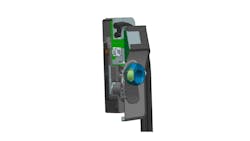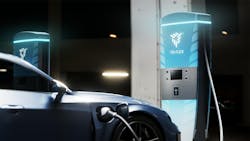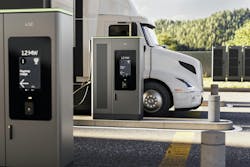Basics of EV charger diagnostics and maintenance
In the long term, investing in electric vehicles means a fleet will spend less on maintenance and deal with fewer unplanned downtime events. The trade-offs are that EVs cost more upfront and usually require charging infrastructure.
But let’s say you get past that, and electric trucks and vans are integrated into your fleet and inching towards a return on investment. Then, all of a sudden, one of your charging stations goes down and several of your trucks are waiting to power up before rolling out on their routes. This can immediately impact a fleet’s customers and delay EV profitability.
It’s a valid concern, but what’s the fix? Charging stations are a relatively new and niche fleet technology compared to gas and diesel pumps, so let’s go through some maintenance and troubleshooting considerations.
How chargers work and why they fail
First, note that a Level 2 charger sends AC power from the grid to the vehicle via a 240v connection, typically with a rate under 20 kW. The vehicle’s onboard charger converts this to DC power before sending it to the battery. DC fast chargers (DCFC) instead convert the grid AC power to DC themselves and send 200 to 1,000 volts right to the battery. This allows for a charging rate of up to 350 kW. In both cases, the EV charger’s chief purpose is to serve as the conduit that bridges the vehicle and the grid.
These are complex systems, of course, and a lot can go wrong, from software and connectivity issues to hardware problems like loose wires. For software issues, the battery management system monitors and regulates the charging. The system needs to know how fast the electrons should flow to the battery, when to stop, and when to slow down (which happens at 80% capacity). This all starts with what’s called the handshake. The EV charger wants to get to know the EV it’s docked to and must also establish a firm understanding of its various parts’ statuses before delivering any power. If the system detects a problem, it will generate fault codes.
“[All EVSE management platforms] provide a translation of fault codes from charging infrastructure, sometimes from vehicles,” said Arcady Sosinov, CEO of Tritium Charging, a charging solutions provider. “Sometimes they do integrations with an OBD II sensor in the vehicle, or [via telematics].”
This is done remotely on a SCADA or OOCP network. Any serious fault codes would be sent to the charger service provider and/or fleet.
Some of the most common fault codes are for non-functioning chargers and connectivity errors, particularly for a charger’s Wi-Fi connection, said Tom Bowen, president of Qmerit Solutions, an EV charger installer and service provider.
“It’s important to be able to distinguish those codes, because oftentimes these can be addressed remotely through the system,” Bowen explained.
Troubleshooting and common problems
Raj Jhaveri, chief technology officer at Greenlane, explained that some of the most common issues chargers encounter include connector wear, communication failures between the charger and vehicle, software glitches, and power fluctuations.
“Other frequent issues we see involve improper grounding, relay failures, open circuits, or communication faults between the EV and the charger,” said Richard Wexler, VP of Global Business Development at Triplett Test Equipment & Tools, which develops testing equipment for EV chargers. “Technicians also run into miswiring or voltage irregularities.”
When a fleet or service provider gets a notification from the software that a charger isn’t working properly, the first step is often to run remote diagnostics, Bowen said. This is followed by remote attempts to repair the charger or restart it. If that fails, a technician will be sent out.
But if the damage isn’t quickly diagnosed, a technician might simply elect to replace an entire charger, especially if it’s a Level 2 that’s under warranty, Qmerit’s Bowen said.
“A Level 2 [charger] will have fewer movable, maintainable parts,” Bowen explained. “If a Level 2 is not functioning, [it’s] usually more cost effective to replace it than try to repair, because the infrastructure is there already.”
Inspections
“One of the first things they tell you to do when you roll up on a machine is just make a visual inspection,” explained Theo Brillhart, technology director at Fluke Electronics, which produces testing and diagnostic equipment. “Has anybody crashed into this thing? Is it compromised by moisture or dust?”
In that visual inspection, it’s also critical to check the cables for dirt or damage, and to make sure their mating surfaces are clean and aren’t corroded. Ensuring that a charger’s circuit breakers and emergency stop button, connector locks, and bus bars are all as they should be is also part of that initial check. If bus bars are loose or corroded, that can cause voltage drops, and even sparking and arcing in extreme cases, Brillhart said.
After a physical inspection, a technician can then run more functionality tests to make sure a charger’s software and firmware are working properly, and that no other updates are needed, Bowen said. It can also help to validate when the dispenser last had a validated charge and when it last communicated with the back-end software through the OCPP messages, said Andrew Richard, CRO and president of Electrify EVSE.
Some companies, like Triplett, offer dedicated EV charging station testers. Triplett’s Wexler recommends testers that “simulate EV load and handshake protocols per IEC 61851 to verify functionality before an actual vehicle is connected.” Some options Triplett provides include an Electric Vehicle Charger Test Kit, an EV Probe Kit, and a Pro Electric Vehicle Charger Test Kit. These are designed to help detect connectivity issues and check for electrical faults, proper voltage, and amperage delivery.
Preventative maintenance
To more actively take care of EV chargers beyond inspections, Fluke’s Brillhart noted that cleaning “is an important part of preventative maintenance. These machines collect a lot of dirt and dust, and many of them have active filtering going on inside to protect the internal components, so those things need to be changed out and/or cleaned.”
This includes cleaning charger contact points and connectors, Bowen explained, emphasizing the importance of regular testing. These functional tests include making sure the charger is responding correctly, that it’s connecting and disconnecting cleanly from a vehicle, and that it can read payment systems properly.
These functional tests are important because “Very often, you can catch software problems just in a routine maintenance visit by exercising the machine a few times,” Brillhart said. “If it doesn’t behave the same way every single time, then you know it quite likely has a bug or needs an update.”
Brillhart also stressed the importance of charger calibration, or making sure that the dispensers are putting out the amount of energy that they should be and at the correct efficiency.
“Because you’re ultimately paying for the electricity, and quite likely lots of it, if you’ve got electric delivery vehicles,” he continued. “So, you want to be sure that they’re operating at their advertised efficiency and that they’re meeting the manufacturer’s warranty requirements, and you can only do that if it’s calibrated.”
Brillhart noted that a lot of these maintenance and some calibration checks can be done with common electrician’s tools like multimeters, current clamps, and thermal imagers.
Getting help
But when a problem comes up and it’s time to service your chargers, a fleet might run into another problem: the capacity of labor.
According to Bowen, “the number of qualified electricians over the last 20 years has dramatically declined.” This trend is a big reason Qmerit exists, he added.
As a result, Bowen said after the installation, some Qmerit customers handle their own EV charger service by hiring their own contractors or even bringing on a service tech.
But that can be “an expensive proposition” due to the hiring, onboarding, training, and travel costs, he said. This is where Qmerit’s platform comes in, which connects contractors to customers while also receiving error codes, service requests, and service tickets.
New charging innovations
There’s been a lot of recent electrification innovation for commercial fleets. This is especially true at ACT Expo 2025, from electric vehicles to chargers and new batteries. Here’s some of the latest on EV chargers:
About the Author

Alex Keenan
Alex Keenan is an Associate Editor for Fleet Maintenance magazine. She has written on a variety of topics for the past several years and recently joined the transportation industry, reviewing content covering technician challenges and breaking industry news. She holds a bachelor's degree in English from Colorado State University in Fort Collins, Colorado.



